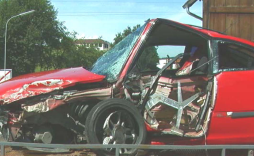Mehr Information
Hauptautor
Eichberger, A.
Co-Autoren
Schimpl, W.; Fellner, B.
Medientyp
PDF-Dokument
Publikationsart
Vortrag
Erscheinungsjahr
2008
Verlag
17. EVU Conference, Nice
Literaturstelle
Eichberger, A.; Schimpl, W.; Fellner, B.: Development of a Crash Test Configuration for Car to Car Frontal Collisions with Small Lateral Overlap. 17th EVU Conference, Nice 2008

English, 8 pages, 9 figures, 11 references
The relevance of frontal car to car collisions with low lateral offset (smaller than 30%) have been investigated in several publications [1, 2, 3, 4, 5, 6]. Low offset frontal collisions showed the same relevance in occurrence and injury risk as “standard” offset crashes (represented by EURO-NCAP 64 km/h frontal crash) and fully overlapped crashes (represented by US-NCAP 56 km/h frontal crash). Up to now, no requirement (legal, consumer test or OEM in-house) takes into account this impact constellation. In low lateral offset crashes the so-called “rim-locking” effect prevents vehicles from sliding off each other and causes collapse of the passenger compartment at comparatively low collision velocities. A suitable crash test configuration for this impact scenario, was already investigated in previous research [2, 6]. A laboratory load case was proposed including a car to car frontal impact
with the following impact configuration:
- Closing speed: Two times 56 km/h = 112 km/h
- Lateral offset: 17%
- Angle of impact: 0°
Performing crash tests with such an impact constellation provides several problems:
- Two cars are involved, so a “base” vehicle serving as antagonist has to be defined
- High impact velocities require large crash facilities
- Accuracy for the lateral offset (two moving vehicles)
- Cost intensive test conduction
- Repeatability and reproducibility of test results
To avoid these shortcomings, the present paper investigates possibilities to simplify the car to car test. Therefore, different moving and non-moving impact obstacles, specially designed for this purpose are investigated. By means of Finite-Element-Method (FEM) computer simulations these simplified test configurations are compared to the original proposed car to car crash test.